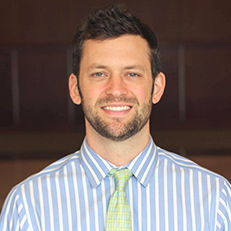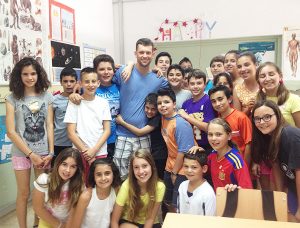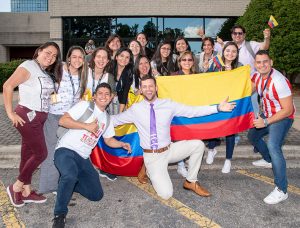Jason Straus is the professional learning specialist at Participate Learning. He has worked in formal and nonformal education for more than eight years, including five years as a classroom teacher.

I was drawn to Participate Learning because of a shared commitment to developing global leadership among today’s students and tomorrow’s leaders. We do this in part by hiring, training, and coaching ambassador teachers, and placing them in K–12 schools in North Carolina, Virginia, and South Carolina. When they bring their cultures and experiences to their schools, they bring the world with them! I have also shared my culture in another country as a teacher, but my experience was very different.
Taking the leap
In September 2013 I was accepted into the Auxiliar de Conversación program to teach English in a dual language elementary school in Málaga, Spain. I remember exactly where I was when I received the news, and I instantly knew I would take the job and that it would change my life forever.
Not knowing much about Spain, I searched online for images of Málaga and was in awe of the beauty of the city. At the time, I wanted nothing more than to completely immerse myself in a Spanish-speaking country. This was the exact opportunity I was looking for.
Moving to another country where I knew no one and had never been before was overwhelming. There was a lot to figure out and so little time to prepare. Where would I live? What paperwork did I need for my visa? How would I get around? What about a cell phone, bank account, and health insurance? I reached out to the program but quickly became frustrated by the lengthy response time and lack of help. Eventually, the program gave me the contact information of my supervisor at the school, who connected me to a current Auxiliar participant and to a Facebook group with others working in Spain. Some answers were emerging, but there were still so many unknowns. Was I really up for this challenge?
Learning a new culture
In October 2013 I said goodbye to my family and boarded the plane to Spain. When I landed at the Málaga airport after 16 hours of travel, there was no one there to greet me. There was no one to help me figure out transportation or grab my bags, so I found a train to the city center—and got lost. After walking around for an hour in a hot and sweaty mess, I found a cafe and connected to the Wi-Fi. Finally, I was able to find the hotel where I had booked a reservation. I arrived and collapsed on the bed.
Adapting to my new life in Spain was no small task. There were immediate challenges, like finding an apartment, buying a SIM card for my phone, and opening up a bank account. Adjusting to a different culture was a longer process. Not having any previous experience with Spanish culture, I was in for some surprises. Dinner is often served as late as 10 p.m., a complete change from the schedule I kept at home. Communicating in Andalusian, the Spanish dialect spoken in the south of Spain, was almost like learning a new language.

Navigating a different educational system built on a set of cultural values that didn’t match my own was just as challenging. I started in the classroom without any training, making my culture shock worse. The only guideline I had was to speak completely in English. However, I felt like half the time I was teaching sign language, and I quickly became frustrated by how little my students could understand.
After two years filled with trial and error, I noticed a difference in my students’ English language abilities, and they were more motivated to learn about US culture. I made many, many mistakes and certainly could have been more effective as a teacher and better adapted to the culture. What was missing was help in the beginning and throughout my time there.
Supporting ambassadors
At Participate Learning, I can play an active role in providing the necessary training and support to our 1,100 ambassador teachers, especially the 341 who arrived this school year. After having an experience in which I had very little support, I feel honored to help our ambassador teachers in such a comprehensive way and set them up for success as soon as they arrive.
Upon arrival, ambassador teachers complete a weeklong training together. About half of their time focuses on training for how to succeed as a teacher in a US classroom. The rest of the time, they get support for setting up their lives in a new country, including the visa process, cell phones, bank accounts, and cars. After that, Participate Learning staff supports them through classroom observations and another comprehensive training later in the year. Ambassador teachers also have access to online webinars and courses, logistical support, and opportunities to connect with fellow teachers to learn as a community.

I am so proud to contribute to this support and training process—especially as I know firsthand what it’s like to navigate a foreign education system. One of my favorite moments is welcoming new ambassador teachers as they descend the escalator to the baggage claim. Looking at them, I recognize the anxious look of someone who has completely uprooted his or her life to live and work abroad, faced with so many unknowns. I always greet new ambassador teachers with a big hug and a reassuring smile, and I can rest assured knowing they have all the tools to successfully navigate their new lives in the United States. I look forward to seeing what the future holds for them!
The ambassador teachers at Participate Learning are warmly welcomed as they begin their adventure of bringing the world to their students. Through our comprehensive orientation and ongoing support, ambassador teachers have the opportunity to start out on the right foot and succeed in their classrooms. Our ambassador teachers remain valuable members of our community even when they return home at the end of the cultural exchange experience. To learn more about the support Participate Learning provides from the moment an ambassador teacher arrives, take a look at this video from the 2019 orientation.




